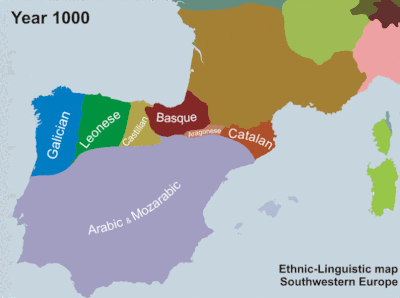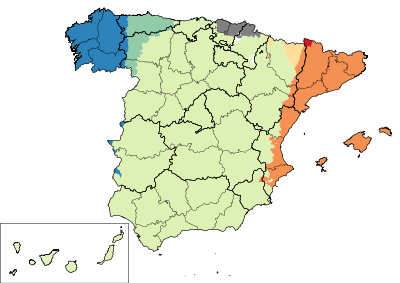
Asturleonese is a Romance language or language family spoken in northwestern Spain and northeastern Portugal, namely in the historical regions and Spain's modern-day autonomous communities of Asturias, northwestern Castile and León, Cantabria and Extremadura, and in Riudenore and Tierra de Miranda in Portugal. The name of the language is largely uncommon among its native speakers, as it forms a dialect continuum of mutually intelligible varieties and therefore it is primarily referred to by various regional glossonyms like Leonese, Cantabrian, Asturian or Mirandese. Extremaduran is sometimes included as well. Asturleonese has been classified by UNESCO as an endangered language, as the varieties are being increasingly replaced by Spanish and Portuguese.
Ribagorçan is a number of Romance dialects spoken in the modern territories of the medieval County of Ribagorza, in northern Spain.
The Iberian Romance, Ibero-Romance or sometimes Iberian languages are a group of Romance languages that developed on the Iberian Peninsula, an area consisting primarily of Spain, Portugal, Gibraltar, Andorra and French Catalonia. They are today more commonly separated into West Iberian, East Iberian (Catalan/Valencian) and Mozarabic language groups. East Iberian's classification is a subject of ongoing scholarly debate, as some argue that the Occitano-Romance languages composed of Occitan along with the aforementioned two are better classified as Gallo-Romance languages.
A regional language is a language spoken in a region of a sovereign state, whether it be a small area, a federated state or province or some wider area.

Spaniards, or Spanish people, are a people native to Spain. Within Spain, there are a number of national and regional ethnic identities that reflect the country's complex history, including a number of different languages, both indigenous and local linguistic descendants of the Roman-imposed Latin language, of which Spanish is the largest and the only one that is official throughout the whole country.

West Iberian is a branch of the Ibero-Romance languages that includes the Castilian languages, Astur-Leonese, Navarro-Aragonese and the descendants of Galician-Portuguese.

Iberism, also known as pan-Iberism or Iberian federalism, is the pan-nationalist ideology supporting a unification of all the territories of the Iberian Peninsula. It mostly encompasses Andorra, Portugal and Spain, but may also include: Gibraltar and territories of France such as Northern Catalonia or the French Basque Country.

Italo-Western is, in some classifications, the largest branch of the Romance languages. It comprises two of the branches of Romance languages: Italo-Dalmatian and Western Romance. It excludes the Sardinian language and Eastern Romance.

Leonese is a set of vernacular Romance language varieties currently spoken in northern and western portions of the historical region of León in Spain, the village of Riudenore and Guadramil in Portugal, sometimes considered another language. In the past, it was spoken in a wider area, including most of the historical region of Leon. The current number of Leonese speakers is estimated at 20,000 to 50,000. Spanish is now the predominant language in the area.

The majority of languages of Spain belong to the Romance language family, of which Spanish is the only one with official status in the whole country. Others, including Catalan and Galician, enjoy official status in their respective autonomous regions, similar to Basque in the northeast of the country. A number of other languages and dialects belonging to the Romance continuum exist in Spain, such as Aragonese, Asturian, Fala and Aranese Occitan.

Asturian is a West Iberian Romance language spoken in the Principality of Asturias, Spain. Asturian is part of a wider linguistic group, the Asturleonese languages. The number of speakers is estimated at 100,000 (native) and 450,000. The dialects of the Astur-Leonese language family are traditionally classified in three groups: Western, Central, and Eastern. For historical and demographic reasons, the standard is based on Central Asturian. Asturian has a distinct grammar, dictionary, and orthography. It is regulated by the Academy of the Asturian Language. Although it is not an official language of Spain, it is protected under the Statute of Autonomy of Asturias and is an elective language in schools. For much of its history, the language has been ignored or "subjected to repeated challenges to its status as a language variety" due to its lack of official status.

The language known today as Spanish is derived from spoken Latin, which was brought to the Iberian Peninsula by the Romans after their occupation of the peninsula that started in the late 3rd century BC. Today it is the world's 4th most widely spoken language, after English, Mandarin Chinese and Hindi. Influenced by the peninsular hegemony of Al-Andalus in the early middle ages, Hispano-Romance varieties borrowed substantial lexicon from Arabic. Upon the southward territorial expansion of the Kingdom of Castile, Hispano-Romance norms associated to this polity displaced both Arabic and the Mozarabic romance varieties in the conquered territories, even though the resulting speech also assimilated features from the latter in the process. The first standard written norm of Spanish was brought forward in the 13th century by Alfonso X the Wise, probably drawing from the speech of the upper classes of Toledo. Features associated with the Castilian patterns of Hispano-Romance also spread west and east to the kingdoms of León and Aragón for the rest of the middle ages, owing to the political prestige achieved by the Kingdom of Castile in the peninsular context and to the lesser literary development of their vernacular norms. From the 1560s onward the standard written form followed Madrid's.

The languages of Portugal are Portuguese, Mirandese, Portuguese Sign Language, Leonese and Caló, with the inclusion of other linguistic entities like argots and transitional languages. Historically, Celtic and Lusitanian were spoken in what is now Portugal.

Both the perceived nationhood of Spain, and the perceived distinctions between different parts of its territory derive from historical, geographical, linguistic, economic, political, ethnic and social factors.

The following outline is provided as an overview of and topical guide to Spain:

Western Romance languages are one of the two subdivisions of a proposed subdivision of the Romance languages based on the La Spezia–Rimini Line. They include the Ibero-Romance and Gallo-Romance. Gallo-Italic may also be included. The subdivision is based mainly on the use of the "s" for pluralization, the weakening of some consonants and the pronunciation of "Soft C" as rather than as in Italian and Romanian.
There is a variety of Vernacular languages spoken in Spain. Spanish, the official language in the entire country, is the predominant native language in almost all of the autonomous communities in Spain. Six of the seventeen autonomous communities in Spain have other co-official languages in addition to Spanish. Bilingualism in different degrees and in distinct communicative situations between Spanish and another language is a habitual practice for many of the Spanish people who reside in one of these autonomous communities.
The various regional and minority languages in Europe encompass four categories:














